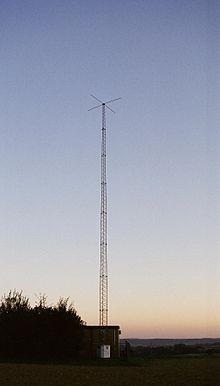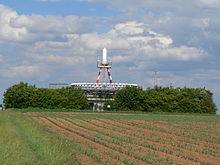Radio beacon

A radio beacon ( English radiobeacon station ) is, according to the definition of the Implementing Regulations for the Radio Service (VO Funk) of the International Telecommunication Union, a radio station of the navigation radio service whose transmissions are intended to enable a mobile radio station to determine its bearing or direction in relation to the radio beacon .
Classification
Basically, radio beacons can be divided into non-directional radio beacons, directional radio beacons and rotating radio beacons. Directed radio beacons include landing course transmitters (localizers), glide slope transmitters (glideslope) and overflight signals (marker beacons), rotary radio beacons include civilian VHF rotary radio beacons (VOR) and military tactical flight navigation (TACAN).
With undirected radio beacons
A non-directional beacon (NDB) is a transmitter that emits a continuous signal equally well in all directions in the long and medium wave range. Its original task was to enable pilots to find their way to airfields, which is why the transmitter is modulated with a (Morse) code for identification. The direction to the NDB, which is marked as a point on maps, can be determined with rotatable directional antennas . In general, two navigation methods can be distinguished:
DF method
In the direction finding method, the receiver can determine the direction of origin of the signal relative to the receiver by means of a rotatable directional antenna or several fixed directional antennas. If you know the directions of two radio beacons, you can deduce your position from it ( cross bearing ).
Hyperbolic method
With the hyperbola method, at least three radio beacons transmit time signals almost simultaneously , which arrive at the receiver slightly offset. From the difference in the signal transit times, the receiver can determine its position relative to the transmitting stations ("My distance from transmitter A is x kilometers greater than my distance from transmitter B"). Since the position of the transmitting stations is known, the geographical position can be derived from it. Hyperbolic methods are therefore not based on determining the direction, but rather on determining the distance. Since the signals from only two transmitting stations result in several possibilities for the calculated position, which are located on a hyperbola (hence the name hyperbolic method), at least three stations are required.
With directional radio beacons
Directed radio beacons transmit preferentially in a certain direction, for example in the approach lane of an airport. In order to be able to build precisely directional antennas, they have to transmit with very short wavelengths in the VHF range. They are used when a vehicle is to follow the beacon emitted by the directional antenna of the transmitter.
In addition, overflight signals (marker beacons) are among the directional radio beacons (see here under "Airborne radio beacons").
With rotary radio beacons
Rotary beacons send a different signal in each direction and are therefore marked with a compass rose on maps. The evaluation of their signals shows the navigator in which direction it is relative to the radio beacon. The direction is denoted by the term radial.
A transmitter system is used for the determination, which in addition to a rotatable narrow main lobe also has an all-round radiator. The transmitter now transmits an audible tone or some other measurable signal to the omnidirectional antenna every time the rotating club passes a certain zero point. The evaluating electronics in the aircraft now determine the relative angle to the radio beacon from the known cycle time of the fire as well as the time between the arrival of the main lobe at the measuring receiver in the aircraft and the acoustic tone.
To determine your own position, you can use an additional radio beacon to establish a cross bearing.
With undirected radio beacons (NDB)
DF method
Hyperbolic method
- GEE
- LORAN
- SHORAN
- Tropics
- Chaika (radio navigation)
- Decca navigation system
- alpha
- Omega navigation procedure
With directional radio beacons
- Early Lorenz A / N system
- Lorenz ultra-short wave landing radio beacon
- Knickebein (radio beacon)
- Instrument Landing System (ILS)
- PRMG
With radio beacons (VOR)
- Telefunken compass transmitter
- further developed Lorenz A / N system
- Sun or consol
- TACAN
- RSBN
While in the maritime beacon have been replaced by more modern satellite navigation procedures and come only in remote areas are used, they are in aviation as part of the IFR ( Instrumental Flight Rules, IFR used more intensively).
However, many marine radio beacons were not shut down, but converted into DGPS radio beacons ( differential GPS ). DGPS radio beacons can easily be distinguished from other radio beacons: DGPS radio beacons only reproduce a noise in the loudspeaker, while conventional radio beacons send their identification permanently as Morse code .
There are also radio beacons which, in addition to their identification, also transmit spoken weather reports for sea or aviation, using the amplitude modulation or compatible single sideband modulation method .
Aeronautical beacon
Aircraft beacons for route navigation are basically divided into:
- Non- directional radio beacons (NDB - non-directional beacon) are located with the ADF (" radio compass ")
- Directional radio beacons (e.g. VOR - Very high frequency Omnidirectional Radio range , TACAN ).
Overflight signs (marker beacons)
Directed radio beacons also include marker beacons. They radiate vertically upwards and cannot be targeted, so they do not give any directional information.
In use since the 1930s, they were initially quite common in route navigation, e.g. B. along airways . This species was then decommissioned until the 1970s.
In contrast, the overflight signs used for approaches with the instrument landing system (ILS) are still used today (outer / middle / inner marker); see the explanations for the entry signs .
VOR, DME, TACAN
With some aeronautical radio navigation methods, a statement about the distance to the aeronautical beacon is possible through suitable, precise time of flight measurements. This is realized by a DME ( Distance Measuring Equipment ), which is set up next to the VOR. In connection with the course information of the VOR aeronautical beacon, position determination is possible at any time.
The course information is based on the fact that the phase shift between a signal emitted in all directions and the directional signal received on the radio line is evaluated. If the aircraft flies z. B. with west course (270 °) towards the VOR ("inbound") or with east course (090 °) away from it ("outbound"), the phase difference between the directional and the undirected signal is 90 °. When approaching the beacon with east course (inbound, 090 °) or departing from this with west course (outbound, 270 °), the phase difference is 270 °.
For a better understanding, the following thought model: A lighthouse emits a short light signal every six minutes evenly in all directions. At the same time, a horizontally circulating, tightly bundled light beam starts, which requires exactly 6 minutes = 360 seconds for a full rotation = 360 degrees, i.e. H. one degree per second. A skipper who sees the bearing beam 135 seconds after the light has flashed at the top of the lighthouse knows that he is on the course line 135 °.
A VOR / DME station also has a DME device (distance measuring device).
In military flight operations, Tactical Air Navigation (TACAN) is (still) used , which is based on a similar principle to VOR, but is more precise by a factor of 1.2 to 2. If VOR and TACAN ground stations are in the same position, the combination is also referred to as VORTAC .
VOR / DME are still the primary sensors required by law in instrument navigation. However, the process is being replaced more and more by GNSS .
Marine radio fire
A marine radio beacon is a radio beacon that is mostly intended for maritime use and is mainly operated in chains, with all marine radio beacons in this chain emitting different Morse code over the course of a cycle time. As with NDBs , the modulation type A2 (sounding telegraphy) is mostly used.
The transmitting antennas and transmitting power of marine radio beacons correspond to those of long-distance radio beacons. In addition, there are marine radio beacons in some countries that transmit weather reports in the AM or SSB . In the course of the increasing spread of GPS , the marine radio beacons in Germany were switched off on January 1st, 2000.
Some of the stations were converted into DGPS stations or NDBs .
See also
- Lighting (describes beacon)
- navigation
- Radio navigation
- List of radio beacons (not exhaustive)
- List of non-directional radio beacons (NDBs) in Germany, Austria and Switzerland
- List of VORs in Germany in the article Drehfunkfeuer
Individual evidence
- ^ VO Funk, 2012, Art. 1.92






